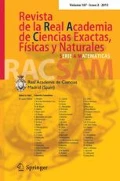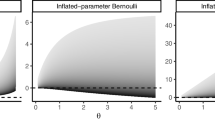Abstract
In this paper, we present a review of results for discrete-time risk models, including the compound binomial risk model and some of its extensions. While most theoretical risk models use the concept of time continuity, the practical reality is discrete. For instance, recursive formulas for discretetime models can be obtained without assuming a claim severity distribution and are readily programmable in practice. Hence themodels, techniques used, and results reviewed here for discrete-time risk models are of independent scientific interest. Yet, results for discrete-time risk models can give, in addition, a simpler understanding of their continuous-time analogue. For example, these results can serve as approximations or bounds for the corresponding results in continuous-time models. This paper will serve as a detailed reference for the study of discrete-time risk models.
Resumen
En este artículo hacemos un repaso de los resultados para modelos de riesgo en tiempo discreto, incluyendo el modelo de riesgo binomial-compuesto, así como algunas de sus extensiones. Aunque gran parte de los modelos teóricos de riesgo se basen en el concepto de continuidad del tiempo, la realidad práctica es en sí discreta. Por ejemplo, en la práctica actuarial se programan fórmulas recursivas para modelos en tiempo discreto, sin necesidad de suponer una distribución de pérdidas conocida. Con lo cual estos modelos, las técnicas y los resultados que listamos para modelos de riesgo en tiempo discreto, generan un cierto interés científico propio. Pero más allá de sus aplicaciones directas, estos resultados para modelos en tiempo discreto también proporcionan un camino más simple hacia los modelos de riesgo análogos en tiempo continuo. Por ejemplo, los resultados en tiempo discreto pueden servir de aproximaciones o de cotas para sus resultados correspondientes en tiempo continuo. El propósito de este artículo es que pueda servir de referencia detallada para el estudio de modelos de riesgo en tiempo discreto.
Similar content being viewed by others
References
Andersen, E. S., (1957). On the collective theory of risk in case of contagion between claims,Bulletin of the Institute of Mathematics and its Applications,12, 275–279.
Asmussen, S., (1989). Ruin theory in a Markovian environment,Scand. Actuar. J.,1989, 69–100.
Asmussen, S., (1992). Phase-type representations in random walk and queuing problems,Ann. Probab.,20, 772–789.
Asmussen, S., (2000).Ruin probabilities, World Scientific, Singapore.
Bobbio, A., Horváth, A., Scarpa, M. andTeleK, M., (2003). Acyclic discrete phase type distributions: properties and a parameter estimation algorithm,Performance Evaluation,54, 1–32.
Cheng, S., Gerber, H. U. andShiu, E. S. W., (2000). Discounted probabilities and ruin theory in the compound binomial model,Insurance Math. Econom.,26, 239–250.
Cossette, H., Landriault, D. andMarceau, E., (2003). Ruin probabilities in the compound Markov binomial model,Scand. Actuar. J.,2003(4), 301–323.
Cossette, H., Landriault, D. andMarceau, E., (2004). Compound binomial risk model in a Markovian environment,Insurance Math. Econom.,35, 425–443.
Cossette, H., Landriault, D. andMarceau, E., (2006). Ruin probabilities in the discrete time renewal risk model,Insurance Math. Econom.,38, 309–323.
Dickson, D. C. M., (1992). On the distribution of surplus prior to ruin,Insurance Math. Econom.,11, 191–207.
Dickson, D. C. M., (1994). Some comments on the compound binomial model,Astin Bull.,24, 33–45.
Dickson, D. C. M., Egidio Reis, A. D. andWaters, H. R., (1995). Some stable algorithms in ruin theory and their applications,Astin Bull.,25, 153–175.
Dickson, D. C. M. andHipp, C., (2001). On the time to ruin for Erlang (2) risk process.Insurance Math. Econom.,29, 333–344.
Gerber, H. U., (1988). Mathematical fun with compound binomial process,Astin Bull.,18(2), 161–168.
Gerber, H. U. andShiu, E. S. W., (1998). On the time value of ruin,N. Am. Actuar. J.,2(1), 48–78.
Gerber, H. U. andShiu, E. S. W., (2005). The time value of ruin in a Sparre Andersen model,N. Am. Actuar. J.,9(2), 49–69.
Landriault, D., (2008). On a generalization of the expected discounted penalty function in a discrete-time insurance risk model,Appl. Stoch. Models Bus. Ind.,24, 525–539.
Latouche, G. andRamaswami, V., (1999).Introduction to matrix analytic methods in stochastic modeling. ASA-SIAM, Philadelphia.
Li, S., (2005). On a class of discrete-time renewal risk models,Scand. Actuar. J.,2005(4), 241–260.
Li, S., (2005). Distributions of the surplus before ruin, the deficit at ruin and the claim causing ruin in a class of discrete time risk models,Scand. Actuar. J.,2005(4), 271–284.
Li, S. and Garrido, J., (2002). On the time value of ruin in the discrete time risk model,Working paper 02–18, Business Economics,University Carlos III of Madrid, 1-28. http://www.uc3m.es/portal/page/portal/dpto economia empresa/investigacion/ workingpaper/workingpapers02/wb021812.pdf
Li, S. andGarrido, J., (2004). On ruin for Erlang(n) risk process,Insurance Math. Econom.,34, 391–408.
Li, S. andGarrido, J., (2005). On a general class of renewal risk process: Analysis of the Gerber-Shiu penalty function,Adv. in Appl. Probab.,37, 836–856.
Lin, X. S. andWillmot, G. E., (1999). Analysis of a defective renewal arising in ruin theory,Insurance Math. Econom.,25, 63–84.
Lin, X. S. andWillmot, G. E., (2000). The moments of the time of ruin, the surplus before ruin, and the deficit at ruin,Insurance Math. Econom.,27, 19–44.
Michel, R., (1989). Representation of a time-discrete probability of eventual ruin,Insurance Math. Econom.,8, 149–152.
Neuts, M. F., (1975). Probability distributions of phase type, in:Liber Amicorum Prof. Emeritus H. Florin. University of Louvain, 173-206.
Neuts, M. F., (1981).Matrix-geometric solutions in stochastic models: An algorithmic approach, Johns Hopkins University Press, Baltimore.
Pavlova, K. andWillmot, G. E., (2004). The discrete stationary renewal risk model and the Gerber-Shiu discounted penalty function,Insurance Math. Econom.,35, 267–277.
Shiu, E. S. W., (1989). The probability of eventual ruin in the compound binomial model,Astin Bull.,19(2), 179–190.
Stanford, D. A. andStroiński, K. J., (1994). Recursive methods for computing finite-time ruin probabilities for phase-distributed claim sizes,Astin Bull.,24, 235–254.
Willmot, G. E., (1993). Ruin probabilities in the compound binomial model,Insurance Math. Econom.,12, 133–142.
Willmot, G. E., (1999). A Laplace transform representation in a class of renewal queueing and risk processes,J. Appl. Probab.,36, 570–584.
Wu, X. and Li, S., (2008). On a discrete-time Sparre Anderson model with phase-type claims, Working paper 08-169, Department of Economics, 1–16.University of Melbourne, http://www.mercury.ecom.unimelb.edu.au/SITE/actwww/wps2008/No169.pdf
Wu, X. and Li, S. (2009). On the Gerber-Shiu function in a discrete time renewal risk model with general inter-claim times,Scand. Actuar. J., to appear.
Yang, H., Zhang, Z. andLan, C., (2009). Ruin problems in a discrete Markov risk model,Statistics and Probability Letters,79, 21–28.
Yuen, K. C. andGuo, J., (2001). Ruin probabilities for time-correlated claims in the compound binomial model,Insurance Math. Econom.,29, 47–57.
Yuen, K. C. andGuo, J., (2006). Some results on the compound binomial model,Scand. Actuar. J.,2006(3), 129–140.
Author information
Authors and Affiliations
Rights and permissions
About this article
Cite this article
Li, S., Lu, Y. & Garrido, J. A review of discrete-time risk models. Rev. R. Acad. Cien. Serie A. Mat. 103, 321–337 (2009). https://doi.org/10.1007/BF03191910
Received:
Accepted:
Issue Date:
DOI: https://doi.org/10.1007/BF03191910
Keywords
- Discrete-time risk model
- compound binomial model
- Sparre Andersen risk model
- compound Markov binomial model
- K m family of distributions
- phase-type distribution
- Gerber-Shiu function
- ruin probability
- surplus before ruin
- deficit at ruin




